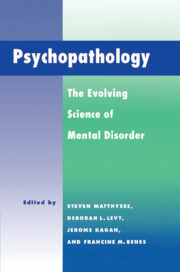Book contents
- Frontmatter
- Contents
- List of Contributors
- Preface
- Brain mechanisms
- 1 Editor's introduction: From controversy to connectivity
- 2 The functional parcellation of dorsolateral prefrontal cortex and the heterogeneous facets of schizophrenia
- 3 Components of working memory deficit in schizophrenia
- 4 Temporal lobe structural abnormalities in schizophrenia: A selective review and presentation of new magnetic resonance findings
- 5 Location, location, location: The pathway from behavior to brain locus in schizophrenia
- 6 The defects of affect and attention in schizophrenia: A possible neuroanatomical substrate
- Development
- Thinking
- Genetics
- Response and reflections
- Author index
- Subject index
1 - Editor's introduction: From controversy to connectivity
Published online by Cambridge University Press: 04 May 2010
- Frontmatter
- Contents
- List of Contributors
- Preface
- Brain mechanisms
- 1 Editor's introduction: From controversy to connectivity
- 2 The functional parcellation of dorsolateral prefrontal cortex and the heterogeneous facets of schizophrenia
- 3 Components of working memory deficit in schizophrenia
- 4 Temporal lobe structural abnormalities in schizophrenia: A selective review and presentation of new magnetic resonance findings
- 5 Location, location, location: The pathway from behavior to brain locus in schizophrenia
- 6 The defects of affect and attention in schizophrenia: A possible neuroanatomical substrate
- Development
- Thinking
- Genetics
- Response and reflections
- Author index
- Subject index
Summary
In medicine and in natural science, it is in general the rule that only the positive findings prove something, but that negative results often only state that we are not able as yet to achieve the positive.
From “The Problem of the Anatomy of Schizophrenia,” by Spielmeyer (1930)In the early part of this century, brain imaging and histopathologic strategies were used extensively to investigate whether there is a neuroanatomic substrate to schizophrenia. Today, it is well known to those who study schizophrenia that these investigations yielded inconsistent findings and ultimately gave rise to a controversy that has been without precedent in the field of neuroscience. In its most essential form, the dispute regarding a structural defect in schizophrenia rested on the dichotomy between the view that schizophrenia is a neurodegenerative disorder and the opposing one, that it is not due to an organic problem. The implication of the latter viewpoint was that schizophrenia is a “functional” entity in which there are no objective changes in the structural integrity of the brain. Those supporting the idea that schizophrenia is a brain disorder were consigned to an historic tomb where no respectable scientists of that era would dare to be found.
As Spielmeyer's quote at the beginning of this section implies, the belief that a structural defect is present in the brains of schizophrenics was less remarkable than the contrary belief, that there is no anatomic substrate to schizophrenia. By supporting the latter possibility, the nay-sayers proved nothing about schizophrenia.
- Type
- Chapter
- Information
- PsychopathologyThe Evolving Science of Mental Disorder, pp. 3 - 6Publisher: Cambridge University PressPrint publication year: 1996
- 1
- Cited by

